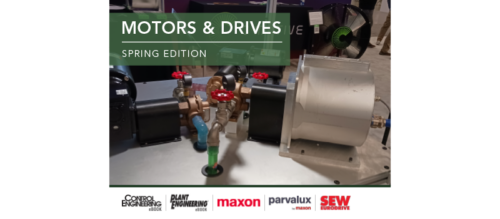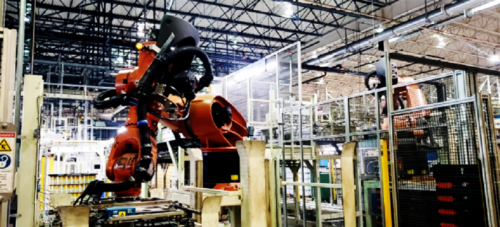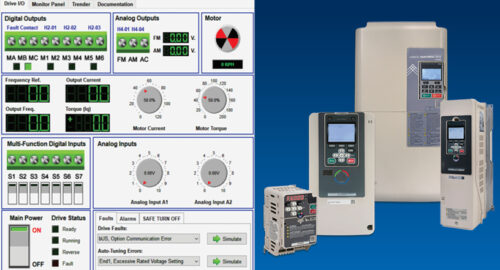Select the right industrial Ethernet device for the job
If you have ever opened the closet in your office where some of the IT equipment is installed, you will find many 19-inch rack-mounted Ethernet devices. Typically, each device has from 24 to 64 ports, or Ethernet connections. The entire rack may contain several hundred connections. This centralized wiring approach is similar to the PLCs in the years before remote I/O.
If you have ever opened the closet in your office where some of the IT equipment is installed, you will find many 19-inch rack-mounted Ethernet devices. Typically, each device has from 24 to 64 ports, or Ethernet connections. The entire rack may contain several hundred connections.
This centralized wiring approach is similar to the PLCs in the years before remote I/O. Typically, commercial or office switches are rack mounted, have a large number of ports and are powered by 120 Vac.
Before the advent of industrial infrastructure components, companies installed separate enclosures on the plant floor that contained the commercial rackmount switches, which typically required some environmental conditioning (Fig. 1). They increased cost, consumed plant floor space and used more cable, because the cabling from the various Ethernet control devices in nearby panels had to be routed back to the centralized enclosures.
Distributed industrial systems
Industrial applications are highly distributed; there are many panels with a small number of intelligent devices per panel (Fig. 2). Many panels need only five to eight ports to connect a PLC, an HMI, a few I/O drops and a spare port for a programming laptop. Panels with more I/O or motion drives might need 16 ports. A larger panel that connects several adjacent panels might need 20 to 24 ports.
Distributed industrial applications also impact the data capacity required. In plant floor control applications, the real-time control messages are short — typically less than 100 bytes of application data per device. While program uploads/downloads require more data, they usually are less time-critical and are required only periodically — not constantly. This means that a data rate of even 10 Mbps provides more bandwidth (data capacity) than is required.
Industrial environmental ratings
If Ethernet infrastructure devices are to be located in panels containing control devices, they will be subjected to the same environmental factors — temperature, humidity, shock, vibration — as the PLCs, I/O, etc., to which they are connected.
There is very little difference between the specs of different vendors for commercial devices, so typically engineers do not pay close attention to the environmental specs; they are all basically the same. This is not true in the industrial Ethernet area. Many new companies with limited industrial experience are entering into the market. Engineers must go back to reviewing spec details. There are significant differences among so-called industrial-rated Ethernet devices.
Temperature and humidity
Commercial and industrial devices have similar humidity ratings. But temperature ratings for industrial Ethernet devices are typically the same as for PLCs and other automation products — usually 0—55 or 60 C. Typically, commercially rated Ethernet devices have a 40 or 45C rating (upper limit). Some products on the market have -40 to 85C ratings for outdoor or process related applications. Be careful, however. A higher temperature-rated product does not necessarily mean a more reliable product.
All major automation companies “derate” their designs. If a chip is rated at 85 C maximum, vendors usually write the product specification so that the chip is exposed to a maximum of only 70 or 75 C. The 10 to 15-degree difference means a major increase in plant floor life because the chip is not stressed to its temperature limit. For higher temperature rated components, ask the vendor for the maximum operating temperature specification of the main integrated circuits. That number should be at least 10 degrees C higher than the published product specification.
Standard Ethernet cables and connectors may not be rated for very cold applications (-40 C). Special low-temperature connectors and cables may be required — at a higher cost.
Beware when comparing mean time between failure (MTBF) ratings. There are different calculation formulas in use, and there is no standardization in the temperatures or operating assumptions used in the formulas. A lower MTBF number from vendor A might mean it was calculated assuming a 55C temperature, while the higher MBTF number from vendor B might be based on room temperature. In this case, if recalculated, the lower MTBF-rated device might have a better calculated MTBF.
Compare apples to apples. A complete MTBF statement should look like “MTBF of x hours (or years) based on the y method at a temperature of z C.” A statement of “MTBF of x hours,” is interesting promotional information, but tells you little that can be used for a true technical comparison.
Shock and vibration
Most automation devices have a shock rating in the range of 15 to 25 G using the IEC 61008 specification. Generally, Ethernet devices fall into this range. But because vibration typically is not an issue in the office environment, it may not be included in the datasheets from commercial vendors or vendors new to the industrial world. With the distributed nature of industrial Ethernet, and the need to mount panels next to motors and on moving machinery, plant floor-experienced vendors always specify vibration. Industrial vibration amplitude ratings typically range from 1 to 5 G.
Electrical noise
The one specification to pay close attention to is the electrical noise immunity of Ethernet devices. Electrical noise problems often manifest themselves in hair-pulling intermittent problems. How Ethernet lines are run inside and outside the panel can result in noise problems. Always follow the vendor’s recommended wiring practices.
Automation devices typically adhere to the IEC 61000-4 series of specifications. Most commercially rated devices use the ANSI specification EN-55024. These specifications include several different types of electrical noise: transients, electromagnetic interference, burst on data lines, power lines, etc. The IEC 61000-4 specifications have noise immunity ratings two to three times higher than the EN-55024 specification.
Many people view the temperature specification of a device as the key industrial rating. However, the electrical noise ratings are even more important because the very high frequencies of 100 Mbps Ethernet can be disrupted by motor starters, soft starters, drives, motors and solenoids — none of which exist in the office environment.
Switches or hubs?
Ethernet networks are created with many point-to-point connections. Infrastructure components such as hubs and switches are used to connect the devices. Ethernet switches are critical to implementing industrial Ethernet systems now, as well as avoiding startup or expansion surprises later.
There is usually some confusion regarding the differences between Ethernet switches and hubs. Both create point-to-point connections. Switches receive Ethernet messages (packets), and like a letter, read the address of the device for which the message is intended, then transmits the message out of only that port to which the device is connected (even if it is connected through several other switches).
Hubs act like “extension cords.” All incoming messages are retransmitted out the ports to every device. Each device sees messages for all the other devices, regardless of the intended destination. The unnecessary traffic slows the network and causes widely varying response times (nondeterministic) caused by many message collisions. These collisions are much like a telephone party line, where two devices try to talk at the same time, then stop and try again, etc. Also, most hubs support only 10 Mbps half-duplex communications.
Ethernet switches avoid collisions by routing messages to only the intended devices. Early on, Ethernet hubs costing several hundreds of dollars were preferred over switches that cost several thousands of dollars. Today, the prices of industrial switches have dropped to hub-price levels of less than $35 per port.
Today’s industrial switches support both 10 Mbps and 100 Mbps Fast Ethernet data rates with full duplex. Most switches also automatically determine the data rate (auto negotiation) and support 10 Mbps or 100 Mbps Ethernet in full or half duplex communications. The combination of the higher determinism (no collisions), lower traffic, full duplex and fast Ethernet connections allows “switched Ethernet” systems to have the predictable and repeatable response times (determinism) needed for control networks. Since the industry is moving from 10 Mbps to 100 Mbps, the ability of switches to connect to both 10 Mbps and 100 Mbps data rates allows easy interconnection of existing and new devices.
Switches simplify the design and layout of the network. Hubs have restrictions in terms of how many can be placed between two communicating devices. The hub layout guidelines change based on data rates, types of cables and types of repeater characteristics of the hub. The use of switches eliminates these complex layout rules. With the availability of low-cost “unmanaged” switches, and their performance and wiring simplification, the trend is to eliminate hubs and use fully switched networks.
Managed or unmanaged switches?
Industrial Ethernet switches are either unmanaged or managed types. Unmanaged switches are the lowest cost and provide basic switching functionality, while managed switches provide added Web page and network diagnostics, redundancy and message filtering functions that can improve application performance.
Unmanaged switches
While unmanaged switches perform the basic switching function, they do not need IP addresses, because they do not have the added intelligence to have Web pages or to perform more advanced functions, etc. Unmanaged switches have fixed port configurations — typically five, eight or 16. They are also available with all-copper ports, or with one or two fiber optic ports. Unmanaged switches are less expensive with port costs at the hub level of less than $35 per port. Managed industrial switches cost in the $110 to $150 per-port range.
Managed switches
Managed switches have built-in Web pages that can be accessed using a standard Internet browser. The Web pages provide remote access to the status of power supplies, alarm contacts, port connections, traffic loading on each port and media types. Managed switches also provide the ability to configure each port’s data rate/duplex, disable unused ports to prevent unauthorized network access and enable redundancy or special message filtering options.
Because managed switches are intelligent devices, like PLCs and PCs they must have IP addresses assigned. Managed switches also provide diagnostic information to PCs containing network management software. Managed switches typically come in 8 or 16-port fixed versions, or expandable versions where copper and fiber optic modules are plugged into a backplane to have custom configurations up to 24 ports.
The Bottom Line…
-
The way manufacturers write their product specifications greatly affects the environmental ratings of industrial Ethernet components.
-
Detailed electrical noise and vibration ratings should be included in a manufacturer’s product specifications because of the noisy nature of industrial applications.
-
The trend is to eliminate hubs and use fully switched networks because of performance, wiring simplification and availability of low-cost unmanaged switches.
-
Larry Komarek has more than 25 years experience in specifying and developing automation products. He can be reached at 717-944-1300, ext. 3625 or at lkomarek@phoenixcon.com .
-
In Part 3 of this series, Larry completes the industrial Ethernet connection by discussing cabling options and control device connections. He also explains how flexibility, performance and lower life cycle costs fuel the growth of industrial Ethernet in a manufacturing plant floor setting.
-
Article edited by Jack Smith, Senior Editor, PLANT ENGINEERING magazine, 630-288-8783, jsmith@reedbusiness.com .
Second of three parts
September — “Create the connection to industrial Ethernet” October — “Select the right industrial Ethernet device for the job”
November — “Completing the industrial Ethernet connection”
NASA-funded program helps manufacturer eliminate hazard
With assistance from the Space Alliance Technology Outreach Program (SATOP), a new concept in visual flow measurements promises to eliminate a workplace hazard in the petrochemical field and other industrial applications.
Process Level Technology (PLT) in League City, TX, designs and manufactures liquid level and flow gauges. PLT owner Wade Donehue devised the CFLOW-360, a magnetically operated sight flow indicator that addresses the need in industrial applications for an alternative to armored-glass sight flow indicators.
Donehue applied magnetic level gauge technology to the flow industry to create a completely sealed sight flow indicator. It provides 360 degrees of visibility, and can been seen for up to 200 feet. Previous designs were difficult to see from any distance and could be viewed from only two angles. The ability to view critical flow lines from greater distances minimizes operator errors in determining flow, as well as operator exposure to hazardous processes.
Conventional glass sight flow indicators incur such health risks that petrochemical companies have banned them. But there was no product to replace them.
“I had the concept, but needed assistance with the turbine design, specifically the size, pitch and overall design of the blades,” said Donehue. He contacted David Braun , a SATOP project engineer. Braun facilitated a meeting between Donehue and Johnnie Engelhardt , senior payload integration engineer at Muniz Engineering Inc. , a Gold-level SATOP Alliance Partner. Engelhardt fashioned the turbine after a standard airfoil, and provided Donehue with the required dimensions and specifications.
The NASA-funded Space Alliance Technology Outreach Program provides small-businesses with free technical assistance through the expertise of the U.S. Space Program, as well as aerospace contractors, NASA field centers, universities and colleges. These organizations join SATOP as Space Alliance Partners and donate time and expertise to help solve technical challenges for small businesses. — Jack Smith
ABB, Intergraph pen cooperative agreement
ABB, Inc. and Intergraph Corp. have signed a cooperative marketing and distribution agreement to support the developed integration between SmartPlant Instrumentation and System 800xA, along with a memorandum of understanding for current and future collaborative development efforts.
SmartPlant Instrumentation is software for instrumentation and control systems engineering, design and maintenance. Industrial
The two companies have collaborated on a number of offerings, including the current System 800xA Process Engineering Tool Integration for SmartPlant Instrumentation, a currently available interface based on ABB’s Web-service technology that enables 800xA configuration to be automated based on SmartPlant Instrumentation content, dynamic context-based access to design documentation from within 800xA, and bi-directional exchange of information between SmartPlant Instrumentation and 800xA. — Jack Smith
Do you have experience and expertise with the topics mentioned in this content? You should consider contributing to our CFE Media editorial team and getting the recognition you and your company deserve. Click here to start this process.





